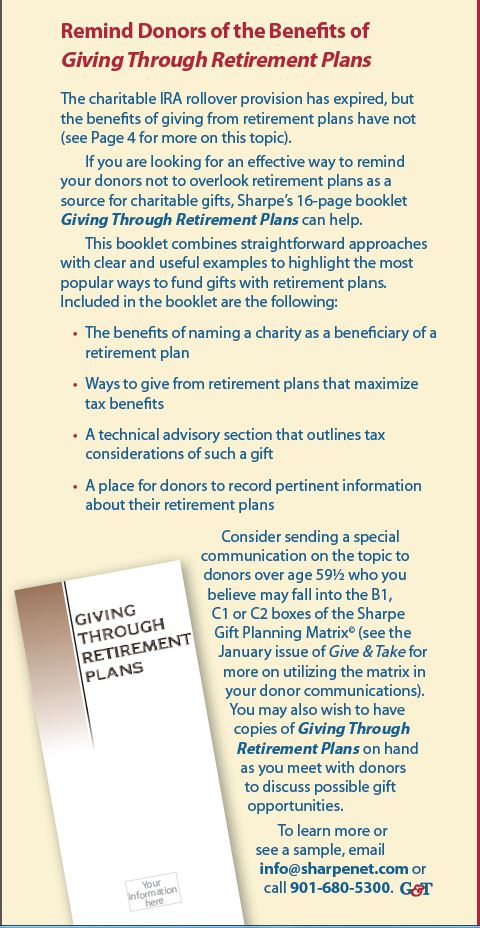By: Barlow Mann
 The charitable IRA provision that allowed donors over 70½ to make direct distributions of up to $100,000 per year to charity expired on December 31, and it is now uncertain whether it will be extended in legislation either this year or in the future.
The charitable IRA provision that allowed donors over 70½ to make direct distributions of up to $100,000 per year to charity expired on December 31, and it is now uncertain whether it will be extended in legislation either this year or in the future.
Since 2006, many have promoted retirement plan gifts by focusing on the special benefits that existed under the now-expired provision. With the opportunity to make gifts directly from IRAs not currently available, fundraisers should take time to remind donors that other ways to make gifts from retirement plans remain under existing law:
- Gifts at death via beneficiary designations and other arrangements
- Withdrawals by those over 59½ followed by outright deductible gifts that can effectively result in tax-free retirement plan gifts
Note also that the special IRA provision applied only to traditional and Roth IRAs. The opportunities outlined here will work with virtually all qualified retirement plans including 401(k)s, 403(b)s and other plans that hold nearly as much as IRAaccounts. The IRA rollover did not apply to these other types of qualified retirement accounts.
Becoming a beneficiary
Donors considering leaving a charitable bequest may not realize that they can also make a meaningful gift simply by naming a favorite charity as the beneficiary of an IRA, 401(k), 403(b) or other retirement plan. Gifts arranged in this manner are generally easy to execute and do not require drafting or amending a will or living trust. The charity may be named as a primary or contingent beneficiary through revision of a readily obtainable form.
Keep in mind, however, that if the account holder is married, the spouse should be informed and may have to consent to the gift. The plan assets may also be left to a charitable or marital trust. In these cases an attorney and possibly other advisors should be consulted.
Why wait?
Depending on their circumstances, donors may also choose to make current gifts using funds withdrawn from their qualified retirement plans. Individuals over 59½ may generally withdraw funds from retirement plans without penalty, make a gift with these funds and then claim an offsetting deduction. In most cases, a gift made in this manner will result in a “wash” for tax purposes.
For higher-income donors affected by the Pease Limitation, the withdrawal would swell adjusted gross income and reduce itemized deductions by 3 percent of the amount of their AGI. This in turn would result in a roughly 1.2 percent “haircut” in the total savings (3 percent of the swollen AGI times the 39.6 percent maximum income tax rate). The good news is that this limitation only applies to individuals with incomes of $254,000 or more ($305,000 in the case of married couples).
A case in point
For example, if John, 62, decides to make a $10,000 gift, he may withdraw $10,000 from his IRA or 401(k) account and give those funds to charity. If he itemizes his deductions, the $10,000 gift should result in a wash for tax purposes, as the $10,000 in income is offset by the $10,000 deduction, resulting in zero net income taxes.

Donors must stay within the overall 50 percent of AGI limitation, and higher-income taxpayers must recognize the possible minimal impact of the Pease limitation. In the previous example, the $10,000 increase in John’s AGI could cause the loss of the benefit of $300 of itemized deductions. If the donor is in a 39.6 percent income tax bracket, the $10,000 gift would result in an increase of taxes of $118.80, meaning that it is a virtual 99 percent wash for tax purposes.
With retirement account balances at record highs and often representing one of the largest financial holdings of middle aged and older donors, fundraisers will want to encourage both current and future gifts of retirement plan assets. Act now to make your donors aware of these gift opportunities.

